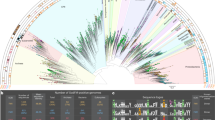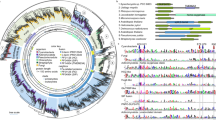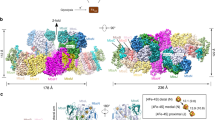Abstract
Mg2+ is essential for RNA folding and catalysis. However, for the first 1.5 billion years of life on Earth RNA inhabited an anoxic Earth with abundant and benign Fe2+. We hypothesize that Fe2+ was an RNA cofactor when iron was abundant, and was substantially replaced by Mg2+ during a period known as the ‘great oxidation’, brought on by photosynthesis. Here, we demonstrate that reversing this putative metal substitution in an anoxic environment, by removing Mg2+ and replacing it with Fe2+, expands the catalytic repertoire of RNA. Fe2+ can confer on some RNAs a previously uncharacterized ability to catalyse single-electron transfer. We propose that RNA function, in analogy with protein function, can be understood fully only in the context of association with a range of possible metals. The catalysis of electron transfer, requisite for metabolic activity, may have been attenuated in RNA by photosynthesis and the rise of O2.
This is a preview of subscription content, access via your institution
Access options
Subscribe to this journal
Receive 12 print issues and online access
$259.00 per year
only $21.58 per issue
Buy this article
- Purchase on Springer Link
- Instant access to full article PDF
Prices may be subject to local taxes which are calculated during checkout


Similar content being viewed by others
References
Anbar, A. D. Oceans. Elements and evolution. Science 322, 1481–1483 (2008).
Hazen, R. M. & Ferry, J. M. Mineral evolution: mineralogy in the fourth dimension. Elements 6, 9–12 (2010).
Prousek, J. Fenton chemistry in biology and medicine. Pure Appl. Chem. 79, 2325–2338 (2007).
Klein, C. Some Precambrian banded iron-formations (BIFs) from around the world: their age, geologic setting, mineralogy, metamorphism, geochemistry, and origin. Am. Mineral. 90, 1473–1499 (2005).
Aguirre, J. D. & Culotta, V. C. Battles with iron: manganese in oxidative stress protection. J. Biol. Chem. 287, 13541–13548 (2012).
Ushizaka, S., Kuma, K. & Suzuki, K. Effects of Mn and Fe on growth of a coastal marine diatom Thalassiosira weissflogii in the presence of precipitated Fe(III) hydroxide and EDTA–Fe(III) complex. Fish. Sci. 77, 411–424 (2011).
Martin, J. E. & Imlay, J. A. The alternative aerobic ribonucleotide reductase of Escherichia coli, NrdEF, is a manganese-dependent enzyme that enables cell replication during periods of iron starvation. Mol. Microbiol. 80, 319–334 (2011).
Cotruvo, J. A. & Stubbe, J. Class I ribonucleotide reductases: metallocofactor assembly and repair in vitro and in vivo. Annu. Rev. Biochem. 80, 733–767 (2011).
Anjem, A., Varghese, S. & Imlay, J. A. Manganese import is a key element of the OxyR response to hydrogen peroxide in Escherichia coli. Mol. Microbiol. 72, 844–858 (2009).
Wolfe-Simon, F., Starovoytov, V., Reinfelder, J. R., Schofield, O. & Falkowski, P. G. Localization and role of manganese superoxide dismutase in a marine diatom. Plant Physiol. 142, 1701–1709 (2006).
Jordan, A. & Reichard, P. Ribonucleotide reductases. Annu. Rev. Biochem. 67, 71–98 (1998).
Athavale, S. S. et al. RNA folding and catalysis mediated by iron(II). PLoS ONE 7, e38024 (2012).
Fox, G. E. Origin and evolution of the ribosome. Cold Spring Harb. Perspect. Biol. 2, a003483 (2010).
Bowman, J. C., Lenz, T. K., Hud, N. V. & Williams, L. D. Cations in charge: magnesium ions in RNA folding and catalysis. Curr. Opin. Struct. Biol. 22, 262–272 (2012).
Auffinger, P., Grover, N. & Westhof, E. Metal ion binding to RNA. Met. Ions Life Sci. 9, 1–35 (2011).
Brion, P. & Westhof, E. Hierarchy and dynamics of RNA folding. Annu. Rev. Biophys. Biomol. Struct. 26, 113–137 (1997).
Stein, A. & Crothers, D. M. Conformational changes of transfer RNA. The role of magnesium(II). Biochemistry 15, 160–168 (1976).
Lynch, D. C. & Schimmel, P. R. Cooperative binding of magnesium to transfer ribonucleic acid studied by a fluorescent probe. Biochemistry 13, 1841–1852 (1974).
Lindahl, T., Adams, A. & Fresco, J. R. Renaturation of transfer ribonucleic acids through site binding of magnesium. Proc. Natl Acad. Sci. USA 55, 941–948 (1966).
Petrov, A. et al. RNA–magnesium–protein interactions in large ribosomal subunit. J. Phys. Chem. B 116, 8113–8120 (2012).
Butcher, S. E. The spliceosome and its metal ions. Met. Ions Life Sci. 9, 235–251 (2011).
Johnson-Buck, A. E., McDowell, S. E. & Walter, N. G. Metal ions: supporting actors in the playbook of small ribozymes. Met. Ions Life Sci. 9, 175–196 (2011).
Josephy, P. D., Eling, T. & Mason, R. P. The horseradish peroxidase-catalyzed oxidation of 3,5,3′,5′-tetramethylbenzidine. Free radical and charge–transfer complex intermediates. J. Biol. Chem. 257, 3669–3675 (1982).
Larson, S. B., Day, J., Greenwood, A. & McPherson, A. Refined structure of satellite tobacco mosaic virus at 1.8 Å resolution. J. Mol. Biol. 277, 37–59 (1998).
Hsiao, C. & Williams, L. D. A recurrent magnesium-binding motif provides a framework for the ribosomal peptidyl transferase center. Nucleic Acids Res. 37, 3134–3142 (2009).
Klein, D. J., Moore, P. B. & Steitz, T. A. The contribution of metal ions to the structural stability of the large ribosomal subunit. RNA 10, 1366–1379 (2004).
Cate, J. H., Hanna, R. L. & Doudna, J. A. A magnesium ion core at the heart of a ribozyme domain. Nature Struct. Biol. 4, 553–558 (1997).
Berens, C., Streicher, B., Schroeder, R. & Hillen, W. Visualizing metal–ion-binding sites in group I introns by iron(II)-mediated Fenton reactions. Chem. Biol. 5, 163–175 (1998).
Zivarts, M., Liu, Y. & Breaker, R. R. Engineered allosteric ribozymes that respond to specific divalent metal ions. Nucleic Acids Res. 33, 622–631 (2005).
Ma, J. et al. Fe2+ binds iron responsive element-RNA, selectively changing protein-binding affinities and regulating mRNA repression and activation. Proc. Natl Acad. Sci. USA 109, 8417–8422 (2012).
Honda, K. et al. Ribosomal RNA in Alzheimer disease is oxidized by bound redox-active iron. J. Biol. Chem. 280, 20978–20986 (2005).
Tsukiji, S., Pattnaik, S. B. & Suga, H. Reduction of an aldehyde by a NADH/Zn2+-dependent redox active ribozyme. J. Am. Chem. Soc. 126, 5044–5045 (2004).
Sen, D. & Poon, L. C. RNA and DNA complexes with hemin [Fe(III) heme] are efficient peroxidases and peroxygenases: how do they do it and what does it mean? Crit. Rev. Biochem. Mol. Biol. 46, 478–492 (2011).
Acknowledgements
The authors thank J. Bada, R. Hazen, K. Barefield, J. Sadighi and D. Jenson for helpful discussions. This work was supported by the National Aeronautics and Space Administration Astrobiology Institute (NNA09DA78A).
Author information
Authors and Affiliations
Contributions
C.H., N.V.H, R.M.W., S.C.H. and L.D.W. conceived and designed the experiments and co-wrote the manuscript. C.H., C.D.O. and I-C.C. performed the experiments and analysed the data. J.C.B., E.B.O'N, S.S.A. and A.P. contributed materials and analysis tools. All the authors discussed the results and contributed to writing and editing the manuscript.
Corresponding author
Ethics declarations
Competing interests
The authors declare no competing financial interests.
Supplementary information
Supplementary information
Supplementary information (PDF 588 kb)
Rights and permissions
About this article
Cite this article
Hsiao, C., Chou, IC., Okafor, C. et al. RNA with iron(II) as a cofactor catalyses electron transfer. Nature Chem 5, 525–528 (2013). https://doi.org/10.1038/nchem.1649
Received:
Accepted:
Published:
Issue Date:
DOI: https://doi.org/10.1038/nchem.1649
This article is cited by
-
The Emergence of Life
Space Science Reviews (2019)
-
Considering planetary environments in origin of life studies
Nature Communications (2018)
-
Lipid vesicles chaperone an encapsulated RNA aptamer
Nature Communications (2018)
-
The plasticity of redox cofactors: from metalloenzymes to redox-active DNA
Nature Reviews Chemistry (2018)
-
In the Beginning was a Mutualism - On the Origin of Translation
Origins of Life and Evolution of Biospheres (2018)



